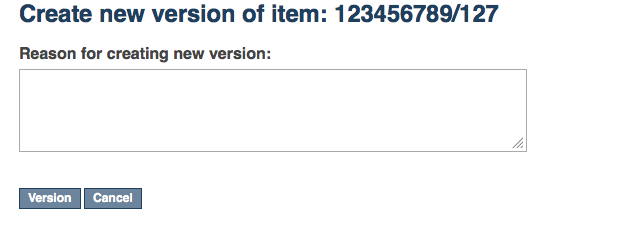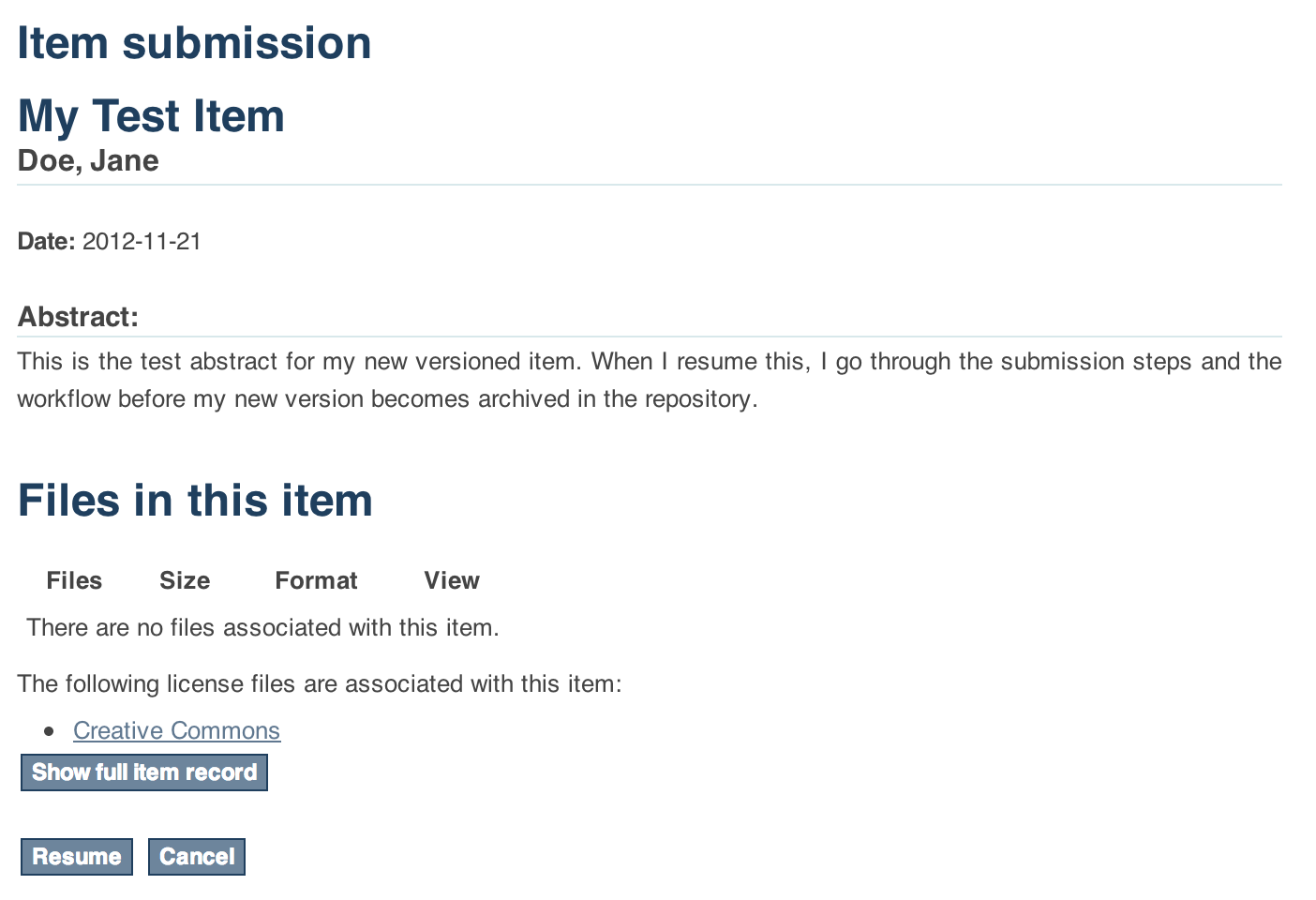...
| Warning |
|---|
| title | AIP Backup & Restore functionality only works with the Latest Version of Items |
|---|
|
If you are using the AIP Backup and Restore functionality to backup / restore / migrate DSpace Content, you must be aware that the "Item Level Versioning" feature is not yet compatible with AIP Backup & Restore. Using them together may result in accidental data loss. Currently the AIPs that DSpace generates only store the latest version of an Item. Therefore, past versions of Items will always be lost when you perform a restore / replace using AIP tools. See | Jira |
|---|
|
| server | DuraSpace JIRA |
|---|
| key | DS-1382 |
|---|
|
| Warning |
|---|
| title | Versioning history exposes data that may be considered personal |
|---|
|
If you enable versioning, the name and email of the submitter are shown to all users by default in Version history. The only way to circumvent this is to make Version history visible only to admins by setting item.history.view.admin=false in [dspace]/config/modules/versioning.cfg. Another solution will be prepared, but only after the 3.0 release. See | Jira |
|---|
| server | DuraSpace JIRA |
|---|
| key | DS-1349 |
|---|
|
|
Initial Requirements
The Item Level Versioning implementation in DSpace 3.0 builds on following requirements identified by the stakeholders who supported this contribution. Initial Requirements Analysis
Initial Requirements
The Item Level Versioning implementation in DSpace 3.0 builds on following requirements identified by the stakeholders who supported this contribution. Initial Requirements Analysis
- What should be Versionable
- Versioning happens at the level of an Individual Item
- Versioning should preserve the current state of metadata, bitstreams and resource policies attached to the item.
- Access, Search and Discovery
- Only the most recent version of an item is available via the search interface
- Previous versions of Items should continue to be visible, citable and accessible
- The
- What should be Versionable
- Versioning happens at the level of an Individual Item
- Versioning should preserve the current state of metadata, bitstreams and resource policies attached to the item.
- Access, Search and Discovery
- Only the most recent version of an item is available via the search interface
- Previous versions of Items should continue to be visible, citable and accessible
- The Bitstreams for previous versions are retained. If something was once retrievable, it should always be retrievable.
- Identifiers
- Each version of an Item is represented by a separate "versioned" identifier
- A base "versionhistory" Identifier points to the most recent version of the Item.
- A revision identifier also exists that is unique to the specific version.
- When a new version of an Item is deposited, a new revision identifier will be created.
- Presentation
- On the item page, there is a link to view previous/subsequent versions.
- By examining the metadata or identifiers, it is possible to determine whether an item is the most recent version, the original version, or an intermediate version.
- Access Control and Rights
- Certain roles should be able to generate a new version of the item via submission.
- To submitters, collection manager, administrators will be given to option to create new version of an item.
- Rights to access a specific Item should transmute as well to previous versions
- Rights to access a specific Bitstream should also transmute to previous versions.to previous versions.
- Data Integrity
- The relationships between versions should not be brittle and breakable by manipulating Item metadata records.
- The relationships between versions should be preserved and predictable in various Metadata Exports (OAI, Packagers, ItemExport)
Data Integrity- The relationships between versions should not be brittle and breakable by manipulating Item metadata records.
- The relationships between versions should be preserved and predictable in various Metadata Exports (OAI, Packagers, ItemExport)
- The relationships between versions should be maintained in SWORD, LNI and AIP packaging and be maintained in updates and restorations.
User Interface
Create a new version of an item
To create a new version of an existing item the following steps have to be performed:
- Search for an Item
- Go to Item view page
- click on "create a new version"
- fill out the form and confirm the operation
.  Image Removed
Image Removed
After the operation is confirmed a new submission process will be generated and the user could modify the metadata and the bitstream(s).
The new version of the item won't be visible until the workflow will be completed.
Access history of an item
To access the history of an item the following steps have to be performed:
...
- be maintained in SWORD, LNI and AIP packaging and be maintained in updates and restorations.
User Interface
Creating a new version of an item
Administrators en collection/community administrators can create new versions of an item from the Item View page.
- Click "Create a new version" from the Context Menu in the navigation bar.
- Provide the reason for creating a new version that will lateron be stored and displayed in the version summary.
 Image Added
Image Added
- Your new version is now creates as a new Item in your Workspace. It requires you to go through the submission and workflow steps like you would do for a normal, new submission to the collection. The rationale behind this is that if you are adding new files or metadata, you will also need to accept the license for them. In addition to this, the versioning functionality does not bypass any quality control embedded in the workflow steps.
 Image Added
Image Added
After the submission steps and the execution of subsequent workflow steps, the new version becomes available in the repository.
View the history and older versions of an item
An overview of the version history, including links to older versions of an item, is available at the bottom of an Item View page. The repository administrator can decide whether the version history should be available to all users or restricted to administrators.
 Image Added
Image Added
Versioning model
For every new Version a separate DSpace Item will be created that replicates the metadata, bundle and bitstream records. The bitstream records will point to the same file on the disk.
...